2023年中考英语Verbs动词的使用课件(共46张PPT)
文档属性
| 名称 | 2023年中考英语Verbs动词的使用课件(共46张PPT) |

|
|
| 格式 | pptx | ||
| 文件大小 | 739.3KB | ||
| 资源类型 | 教案 | ||
| 版本资源 | 通用版 | ||
| 科目 | 英语 | ||
| 更新时间 | 2023-06-21 18:46:26 | ||
图片预览

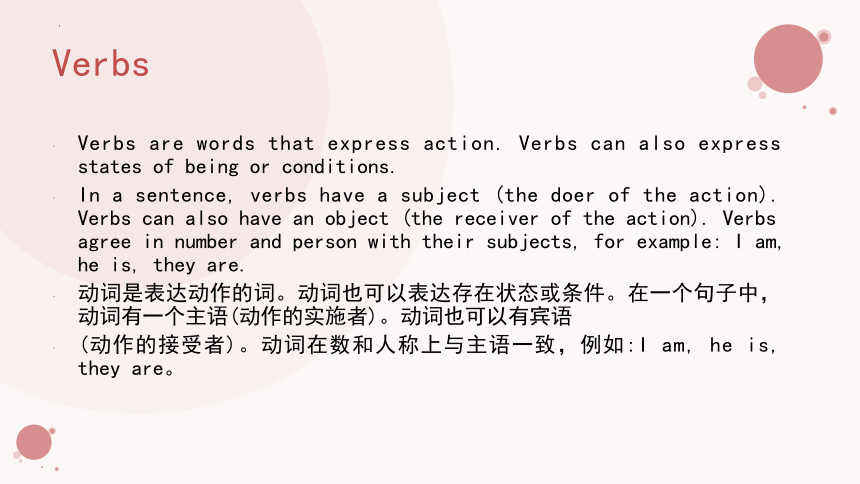
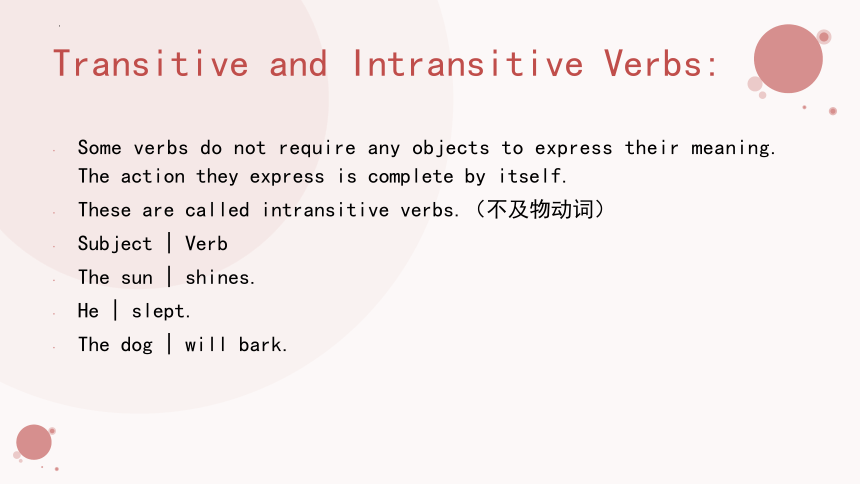


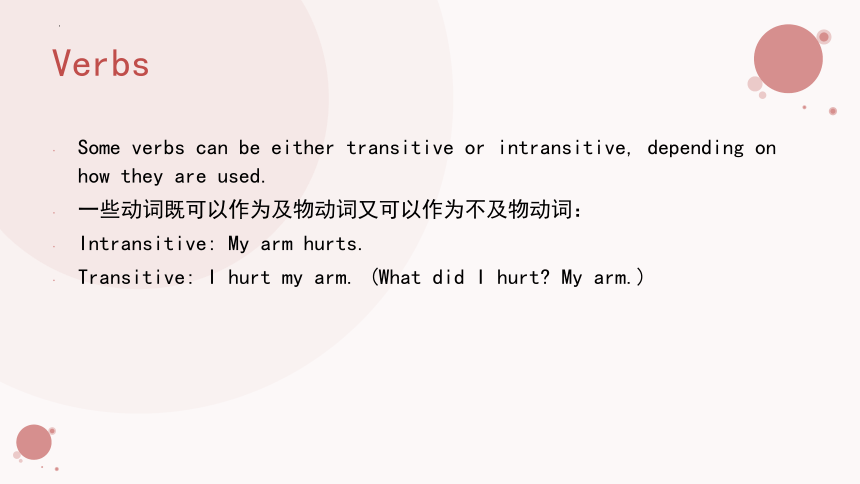
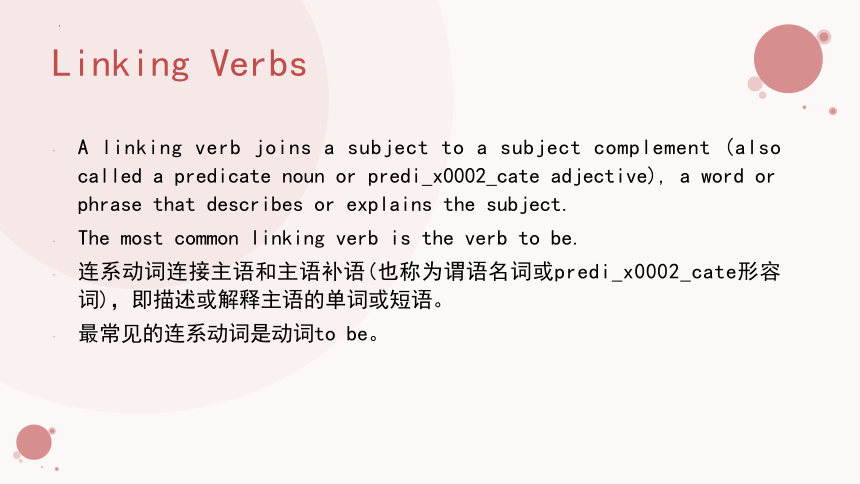
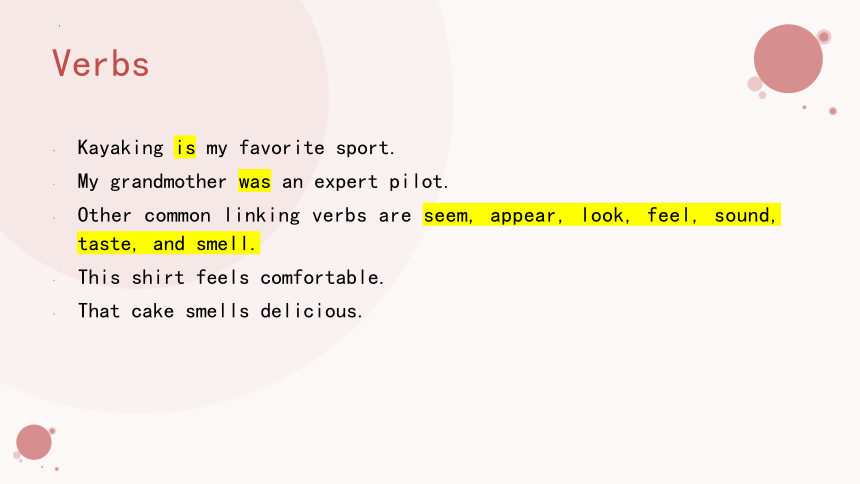
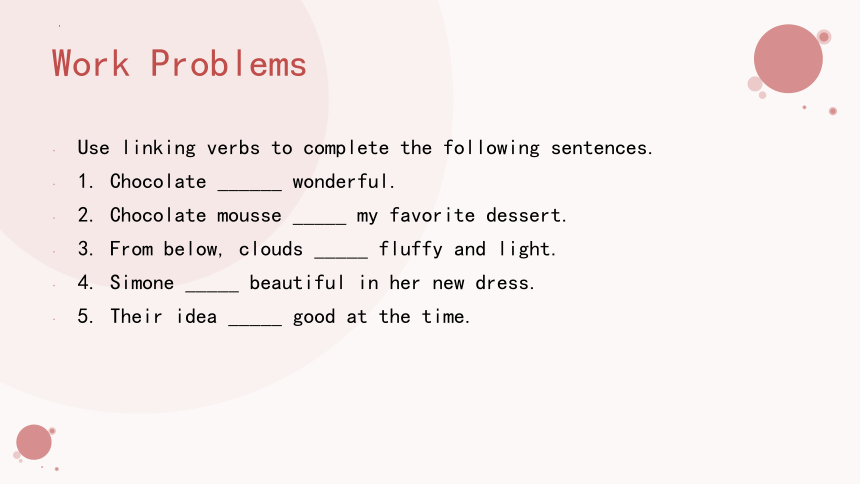
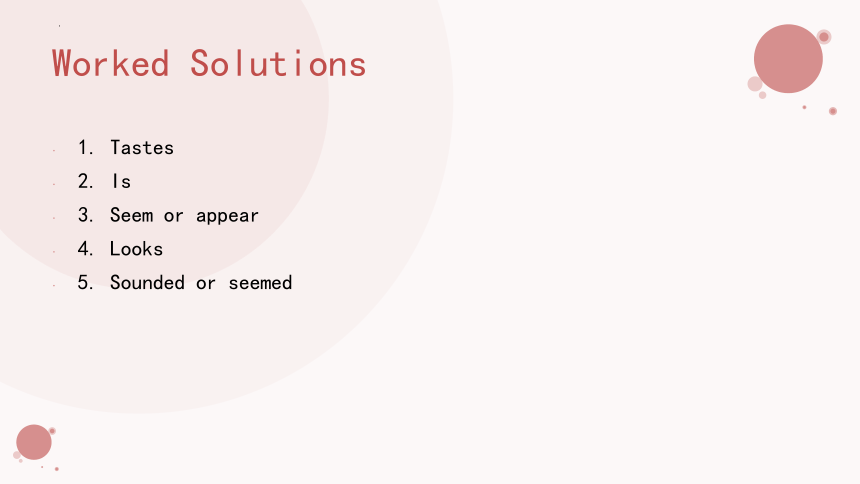
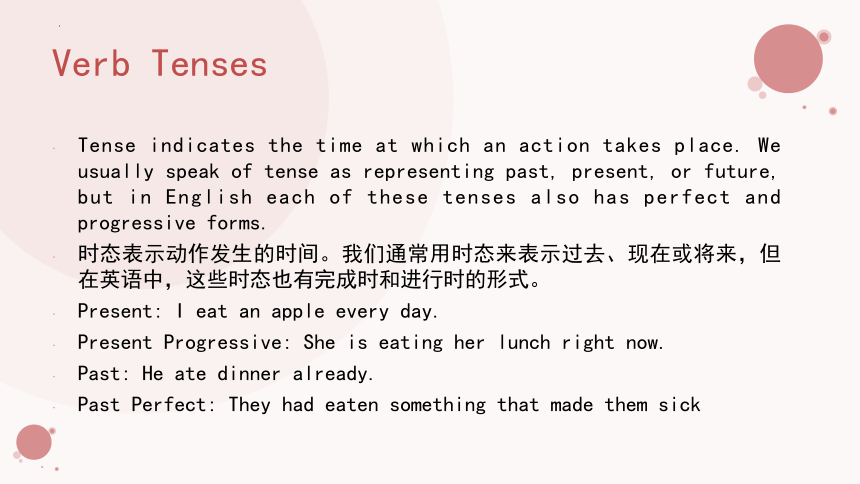
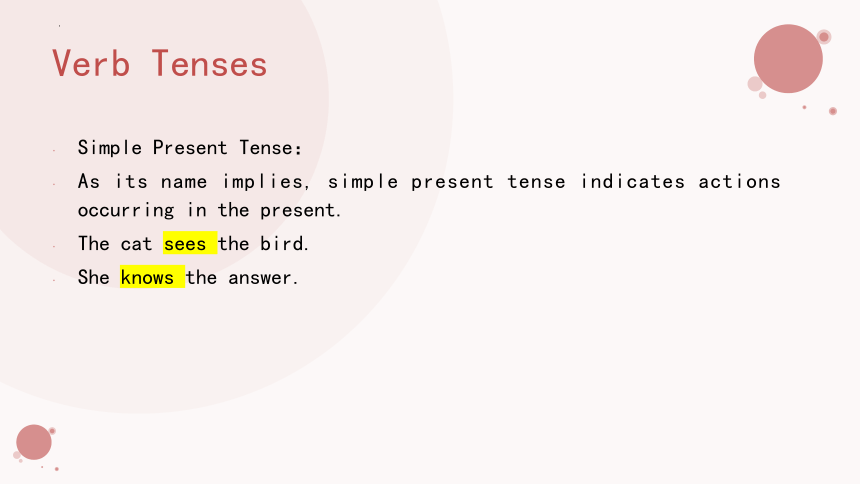
文档简介
(共46张PPT)
LOREM IPSUM DOLOR LOREM
Verbs动词的使用
Verbs
Verbs are words that express action. Verbs can also express states of being or conditions.
In a sentence, verbs have a subject (the doer of the action). Verbs can also have an object (the receiver of the action). Verbs agree in number and person with their subjects, for example: I am, he is, they are.
动词是表达动作的词。动词也可以表达存在状态或条件。在一个句子中,动词有一个主语(动作的实施者)。动词也可以有宾语
(动作的接受者)。动词在数和人称上与主语一致,例如:I am, he is, they are。
Transitive and Intransitive Verbs:
Some verbs do not require any objects to express their meaning. The action they express is complete by itself.
These are called intransitive verbs.(不及物动词)
Subject | Verb
The sun | shines.
He | slept.
The dog | will bark.
Verbs
However, some verbs require an object (the receiver of the action) to complete their meaning.
These are called transitive verbs. Transitive verbs cannot make sense unless they are followed by a direct object. A direct object tells who or what received the action of the verb.
然而,有些动词需要宾语(动作的接受者)来完成它们的意思。
这些被称为及物动词。及物动词后面必须跟一个直接宾语,否则是没有意义的。直接宾语告诉谁或什么接受了动词的动作。
Verbs
及物动词的例句:
Subject | Verb | Direct Object
Jorge | mailed | a letter. (What did Jorge mail A letter.)
Julia | bought | a bicycle. (What did Julia buy A bicycle.)
We | saw | our friends. (Whom did we see Our friends.)
Verbs
Some verbs can be either transitive or intransitive, depending on how they are used.
一些动词既可以作为及物动词又可以作为不及物动词:
Intransitive: My arm hurts.
Transitive: I hurt my arm. (What did I hurt My arm.)
Linking Verbs
A linking verb joins a subject to a subject complement (also called a predicate noun or predi_x0002_cate adjective), a word or phrase that describes or explains the subject.
The most common linking verb is the verb to be.
连系动词连接主语和主语补语(也称为谓语名词或predi_x0002_cate形容词),即描述或解释主语的单词或短语。
最常见的连系动词是动词to be。
Verbs
Kayaking is my favorite sport.
My grandmother was an expert pilot.
Other common linking verbs are seem, appear, look, feel, sound, taste, and smell.
This shirt feels comfortable.
That cake smells delicious.
Work Problems
Use linking verbs to complete the following sentences.
1. Chocolate ______ wonderful.
2. Chocolate mousse _____ my favorite dessert.
3. From below, clouds _____ fluffy and light.
4. Simone _____ beautiful in her new dress.
5. Their idea _____ good at the time.
Worked Solutions
1. Tastes
2. Is
3. Seem or appear
4. Looks
5. Sounded or seemed
Verb Tenses
Tense indicates the time at which an action takes place. We usually speak of tense as representing past, present, or future, but in English each of these tenses also has perfect and progressive forms.
时态表示动作发生的时间。我们通常用时态来表示过去、现在或将来,但在英语中,这些时态也有完成时和进行时的形式。
Present: I eat an apple every day.
Present Progressive: She is eating her lunch right now.
Past: He ate dinner already.
Past Perfect: They had eaten something that made them sick
Verb Tenses
Simple Present Tense:
As its name implies, simple present tense indicates actions occurring in the present.
The cat sees the bird.
She knows the answer.
Verbs
Simple present tense also indicates habitual, customary, repeated, or permanent actions or conditions.
My karate class meets on Thursdays.
Dave smokes too many cigarettes.
I drink a cup of coffee before I go to work.
Horned toads live in the desert.
Verbs
疑问句与否定句的构成:
The cat sees the bird.
Question: Does the cat see the bird
Negative: The cat does not see the bird.
My karate class meets on Thursdays.
Question: Does my karate class meet on Thursdays
Negative: My karate class does not meet on Thursdays.
Verbs
注意:
Only the simple present tense verb to be does not use the do auxiliary.
The sky is blue.
Is the sky blue
The sky is not blue.
Example Problems
Change the verb in the first sentence to fit in the second sentence.
1. We enjoy running. Marcus also _____ running.
Answer: Enjoys. (third person singular, add –s to the base form)
2. They go to the beach. Kate also _____ to the beach.
Answer: Goes. (third person singular, ends in –o, so add –es)
3. I carry a backpack. Carmen also _____ a backpack.
Answer: Carries. (third person singular, ends in consonant + y, change y to i, and then
add –es)
Simple Past Tense
Simple past tense indicates an action that took place in the past.
Alfred Hitchcock directed many great films.
The cat chased the bird.
I ate breakfast this morning.
We saw a Broadway play when we visited New York.
Verbs
To form the simple past of most English verbs, simply add –ed to the base form. If the base form
ends in consonant + y, change the y to i before adding –ed.
talk → talked
need → needed
carry → carried
If the base form ends in consonant + e, add –d.
bake → baked
arrive → arrived
Verbs
If the base form ends in vowel + consonant, double the consonant if the last syllable is stressed
or the word has only one syllable.
permit → permitted
transmit → transmitted
step → stepped
plan → planned
Verbs
However, many common English verbs are irregular in past tense. These verbs change forms
completely in simple past. For example:
see → saw
eat → ate
take → took
do → did
Example Problems
Following the examples above, change the simple past tense sentences to questions, and then
give a negative answer.
Farah asked me to meet her at the mall.
Answer: Did Farah ask me to meet her at the mall
Answer: Farah did not ask me to meet her at the mall.
Work Problems
Change the verb in each sentence from simple present to simple past tense.
1. Helen eats her lunch at noon.
2. Her friends wait for her in the park.
3. They go to a restaurant.
4. She stops to feed the birds by the fountain.
5. She seldom varies this routine.
Worked Solutions
1. Helen ate her lunch at noon. (irregular past tense form)
2. Her friends waited for her in the park. (regular form, add –ed to base form)
3. They went to a restaurant. (irregular past tense form)
4. She stopped to feed the birds by the fountain. (regular form, base form is a single syllable
ending in vowel + consonant, so double the final letter before adding –ed)
5. She seldom varied this routine. (regular form, base form vary ends in consonant + y, so
change y to i, and then add –ed)
Simple Future Tense
Simple future tense indicates an action that has not yet taken place.
We will go to Germany next summer.
They will meet you at the coffee shop at seven o’clock.
The contractor will finish the project by Friday.
Simple Future Tense
The pattern for forming simple future tense is as follows:
Will + base form of verb
Will is one of a small group of verbs called modal auxiliaries that do not vary in form
To form the negative of a simple future verb, place not between the auxiliary will and the base
verb. To form a question, move will to the beginning of the sentence, in front of the subject.
They will meet you at the coffee shop.
Will they meet you at the coffee shop
They will not meet you at the coffee shop.
Present Progressive Tense
Present progressive tense indicates an action currently in progress or actively taking place.
She is talking to her friends right now.
We are negotiating with a new supplier.
The cookies are baking, and they will be ready soon.
The pattern for forming present progressive tense is as follows:
Present tense form of be + present participle:
march → marching
ache → aching
hit → hitting
But: snoop → snooping
Verbs
To form the negative, place not between the auxiliary be and the present participle. To form a
question, move the auxiliary to the beginning of the sentence, before the subject.
She is talking to her friends.
She is not talking to her friends.
Is she talking to her friends
Past Progressive Tense
Past progressive tense indicates an event that was in progress at a particular point in the past.
She was cooking dinner when I called.
While you were wasting time, I was doing all the work.
We were watching television at eight o’clock.
The pattern for forming past progressive is as follows:
Simple past tense form of to be + present participle
Example Problems
Change the simple past tense verb to past progressive.
1. We looked for you last night.
Answer: We were looking for you last night.
Were (first person plural) agrees with the subject we. To form the present participle of
look, simply add –ing.
2. The party went well.
Answer: The party was going well.
Was (third person singular) agrees with the subject party. Went is the irregular past tense
form of the verb go. To form the present participle, add –ing to the base form. (By itself,
this sentence does not make much sense in past progressive tense. It would be more
helpful to put a specific, single event in the sentence to contrast with the progressive
action, such as: The party was going well until the couch caught on fire.)
Future Progressive Tense
Future progressive tense indicates an event that will be in progress at a specific point in the future.
My family will be taking a vacation the first week in June.
We will be staying at a resort in Florida.
My uncle will be running the family business while we are gone.
The pattern for forming future progressive tense is as follows:
Will be + present participle
Verbs
To form the negative, place not between will and be. To form a question, move will to the be_x0002_ginning of the sentence, before the subject.
Juan will be directing work on the project.
Will Juan be directing work on the project
Juan will not be directing work on the project
Present Perfect Tense
Despite its name, present perfect tense normally does not refer to actions occurring in the pre_x0002_sent. Instead, it most often refers to actions completed in the past that have some consequence
or effect on the present situation.
I have tried to tell him to slow down, but he will not listen.
Mr. Jones has ordered a new couch for his house, but it has not arrived yet.
Stan has broken his leg, so he cannot go on the ski trip with us.
Present Perfect Tense
Present perfect tense also refers to continuous actions begun in the past and extending into the
present.
I have lived in California for three years.
My mother has wanted to visit India since she was a little girl.
The pattern for forming present perfect tense is as follows:
Simple present tense form of have + past participle of the verb
For most verbs, the past participle is the same as the simple past form.
try → tried
look → looked
Past Perfect Tense
Past perfect tense indicates an action that preceded another action in the past.
过去完成时表示发生在过去另一个动作之前的动作。
The building had burned completely by the time the fire department arrived.
I had visited London several times before I decided to move there.
Verbs
Past perfect tense is often used in narratives, with said.
She said that she had talked to you last night.
We told Mr. James that you had washed his car.
The pattern for forming past perfect tense is as follows:
Had + past participle
Verbs
To form the negative, place not between had and the past participle. To form a question, move
had to the beginning of sentence, before the subject.
She had taken a wrong turn.
Had she taken a wrong turn
She had not taken a wrong turn.
Verbs
Past perfect tense is often accompanied by yet, never, and already. These words go between
had and the past participle:
She knew that she had already taken a wrong turn
Future Perfect Tense
Future perfect tense indicates an event that will be completed by a specific point in the future.
We will have finished the project by the end of the week.
The movie will have ended before we can get there.
She will have left her house by now.
The pattern for forming future perfect tense is as follows:
Will have + past participle
Future Perfect Tense
To form the negative, place not between will and have. To form a question, move will to the
beginning of the sentence, in front of the subject.
They will have gone by now.
Will they have gone by now
They will not have gone by now.
Present Perfect Progressive Tense
Present perfect progressive tense indicates an ongoing event begun in the past and continuing
into the present.
She has been looking tired lately.
We have been taking dance lessons for three weeks now.
Present Perfect Progressive Tense
The pattern for forming present perfect progressive tense is as follows:
Present tense form of have + been + present participle
To form the negative, place not between the have auxiliary and been. To form a question, move
the have auxiliary to the beginning of the sentence, in front of the subject.
She has been looking tired.
Has she been looking tired
She has not been looking tired.
Past Perfect Progressive Tense
Past perfect progressive tense indicates an ongoing event that was completed in the past, prior
to some other past event.
We had been looking for a house for six months when we found this one.
Mark had been applying for other jobs before he was laid off.
The pattern for forming past perfect progressive tense is as follows:
Had + been + present participle
Past Perfect Progressive Tense
To form the negative, place not between had and been. To form a question, move had to the
beginning of the sentence, in front of the subject.
We had been looking for a house.
Had we been looking for a house
We had not been looking for a house
Future Perfect Progressive Tense
Future perfect progressive tense indicates an ongoing event that will be completed by a certain
point in the future.
The party will have been going for ages by the time we arrive.
In just half an hour from now, we will have been working for 14 hours straight.
The pattern for forming future perfect progressive tense is as follows:
Will have been + present participle
Future Perfect Progressive Tense
To form the negative, place not between the auxiliaries will and have. To form a question, move
will to the beginning of the sentence, in front of the subject.
They will have been preparing the food.
Will they have been preparing the food
They will not have been preparing the food.
Verbs
Thank you!
LOREM IPSUM DOLOR LOREM
Verbs动词的使用
Verbs
Verbs are words that express action. Verbs can also express states of being or conditions.
In a sentence, verbs have a subject (the doer of the action). Verbs can also have an object (the receiver of the action). Verbs agree in number and person with their subjects, for example: I am, he is, they are.
动词是表达动作的词。动词也可以表达存在状态或条件。在一个句子中,动词有一个主语(动作的实施者)。动词也可以有宾语
(动作的接受者)。动词在数和人称上与主语一致,例如:I am, he is, they are。
Transitive and Intransitive Verbs:
Some verbs do not require any objects to express their meaning. The action they express is complete by itself.
These are called intransitive verbs.(不及物动词)
Subject | Verb
The sun | shines.
He | slept.
The dog | will bark.
Verbs
However, some verbs require an object (the receiver of the action) to complete their meaning.
These are called transitive verbs. Transitive verbs cannot make sense unless they are followed by a direct object. A direct object tells who or what received the action of the verb.
然而,有些动词需要宾语(动作的接受者)来完成它们的意思。
这些被称为及物动词。及物动词后面必须跟一个直接宾语,否则是没有意义的。直接宾语告诉谁或什么接受了动词的动作。
Verbs
及物动词的例句:
Subject | Verb | Direct Object
Jorge | mailed | a letter. (What did Jorge mail A letter.)
Julia | bought | a bicycle. (What did Julia buy A bicycle.)
We | saw | our friends. (Whom did we see Our friends.)
Verbs
Some verbs can be either transitive or intransitive, depending on how they are used.
一些动词既可以作为及物动词又可以作为不及物动词:
Intransitive: My arm hurts.
Transitive: I hurt my arm. (What did I hurt My arm.)
Linking Verbs
A linking verb joins a subject to a subject complement (also called a predicate noun or predi_x0002_cate adjective), a word or phrase that describes or explains the subject.
The most common linking verb is the verb to be.
连系动词连接主语和主语补语(也称为谓语名词或predi_x0002_cate形容词),即描述或解释主语的单词或短语。
最常见的连系动词是动词to be。
Verbs
Kayaking is my favorite sport.
My grandmother was an expert pilot.
Other common linking verbs are seem, appear, look, feel, sound, taste, and smell.
This shirt feels comfortable.
That cake smells delicious.
Work Problems
Use linking verbs to complete the following sentences.
1. Chocolate ______ wonderful.
2. Chocolate mousse _____ my favorite dessert.
3. From below, clouds _____ fluffy and light.
4. Simone _____ beautiful in her new dress.
5. Their idea _____ good at the time.
Worked Solutions
1. Tastes
2. Is
3. Seem or appear
4. Looks
5. Sounded or seemed
Verb Tenses
Tense indicates the time at which an action takes place. We usually speak of tense as representing past, present, or future, but in English each of these tenses also has perfect and progressive forms.
时态表示动作发生的时间。我们通常用时态来表示过去、现在或将来,但在英语中,这些时态也有完成时和进行时的形式。
Present: I eat an apple every day.
Present Progressive: She is eating her lunch right now.
Past: He ate dinner already.
Past Perfect: They had eaten something that made them sick
Verb Tenses
Simple Present Tense:
As its name implies, simple present tense indicates actions occurring in the present.
The cat sees the bird.
She knows the answer.
Verbs
Simple present tense also indicates habitual, customary, repeated, or permanent actions or conditions.
My karate class meets on Thursdays.
Dave smokes too many cigarettes.
I drink a cup of coffee before I go to work.
Horned toads live in the desert.
Verbs
疑问句与否定句的构成:
The cat sees the bird.
Question: Does the cat see the bird
Negative: The cat does not see the bird.
My karate class meets on Thursdays.
Question: Does my karate class meet on Thursdays
Negative: My karate class does not meet on Thursdays.
Verbs
注意:
Only the simple present tense verb to be does not use the do auxiliary.
The sky is blue.
Is the sky blue
The sky is not blue.
Example Problems
Change the verb in the first sentence to fit in the second sentence.
1. We enjoy running. Marcus also _____ running.
Answer: Enjoys. (third person singular, add –s to the base form)
2. They go to the beach. Kate also _____ to the beach.
Answer: Goes. (third person singular, ends in –o, so add –es)
3. I carry a backpack. Carmen also _____ a backpack.
Answer: Carries. (third person singular, ends in consonant + y, change y to i, and then
add –es)
Simple Past Tense
Simple past tense indicates an action that took place in the past.
Alfred Hitchcock directed many great films.
The cat chased the bird.
I ate breakfast this morning.
We saw a Broadway play when we visited New York.
Verbs
To form the simple past of most English verbs, simply add –ed to the base form. If the base form
ends in consonant + y, change the y to i before adding –ed.
talk → talked
need → needed
carry → carried
If the base form ends in consonant + e, add –d.
bake → baked
arrive → arrived
Verbs
If the base form ends in vowel + consonant, double the consonant if the last syllable is stressed
or the word has only one syllable.
permit → permitted
transmit → transmitted
step → stepped
plan → planned
Verbs
However, many common English verbs are irregular in past tense. These verbs change forms
completely in simple past. For example:
see → saw
eat → ate
take → took
do → did
Example Problems
Following the examples above, change the simple past tense sentences to questions, and then
give a negative answer.
Farah asked me to meet her at the mall.
Answer: Did Farah ask me to meet her at the mall
Answer: Farah did not ask me to meet her at the mall.
Work Problems
Change the verb in each sentence from simple present to simple past tense.
1. Helen eats her lunch at noon.
2. Her friends wait for her in the park.
3. They go to a restaurant.
4. She stops to feed the birds by the fountain.
5. She seldom varies this routine.
Worked Solutions
1. Helen ate her lunch at noon. (irregular past tense form)
2. Her friends waited for her in the park. (regular form, add –ed to base form)
3. They went to a restaurant. (irregular past tense form)
4. She stopped to feed the birds by the fountain. (regular form, base form is a single syllable
ending in vowel + consonant, so double the final letter before adding –ed)
5. She seldom varied this routine. (regular form, base form vary ends in consonant + y, so
change y to i, and then add –ed)
Simple Future Tense
Simple future tense indicates an action that has not yet taken place.
We will go to Germany next summer.
They will meet you at the coffee shop at seven o’clock.
The contractor will finish the project by Friday.
Simple Future Tense
The pattern for forming simple future tense is as follows:
Will + base form of verb
Will is one of a small group of verbs called modal auxiliaries that do not vary in form
To form the negative of a simple future verb, place not between the auxiliary will and the base
verb. To form a question, move will to the beginning of the sentence, in front of the subject.
They will meet you at the coffee shop.
Will they meet you at the coffee shop
They will not meet you at the coffee shop.
Present Progressive Tense
Present progressive tense indicates an action currently in progress or actively taking place.
She is talking to her friends right now.
We are negotiating with a new supplier.
The cookies are baking, and they will be ready soon.
The pattern for forming present progressive tense is as follows:
Present tense form of be + present participle:
march → marching
ache → aching
hit → hitting
But: snoop → snooping
Verbs
To form the negative, place not between the auxiliary be and the present participle. To form a
question, move the auxiliary to the beginning of the sentence, before the subject.
She is talking to her friends.
She is not talking to her friends.
Is she talking to her friends
Past Progressive Tense
Past progressive tense indicates an event that was in progress at a particular point in the past.
She was cooking dinner when I called.
While you were wasting time, I was doing all the work.
We were watching television at eight o’clock.
The pattern for forming past progressive is as follows:
Simple past tense form of to be + present participle
Example Problems
Change the simple past tense verb to past progressive.
1. We looked for you last night.
Answer: We were looking for you last night.
Were (first person plural) agrees with the subject we. To form the present participle of
look, simply add –ing.
2. The party went well.
Answer: The party was going well.
Was (third person singular) agrees with the subject party. Went is the irregular past tense
form of the verb go. To form the present participle, add –ing to the base form. (By itself,
this sentence does not make much sense in past progressive tense. It would be more
helpful to put a specific, single event in the sentence to contrast with the progressive
action, such as: The party was going well until the couch caught on fire.)
Future Progressive Tense
Future progressive tense indicates an event that will be in progress at a specific point in the future.
My family will be taking a vacation the first week in June.
We will be staying at a resort in Florida.
My uncle will be running the family business while we are gone.
The pattern for forming future progressive tense is as follows:
Will be + present participle
Verbs
To form the negative, place not between will and be. To form a question, move will to the be_x0002_ginning of the sentence, before the subject.
Juan will be directing work on the project.
Will Juan be directing work on the project
Juan will not be directing work on the project
Present Perfect Tense
Despite its name, present perfect tense normally does not refer to actions occurring in the pre_x0002_sent. Instead, it most often refers to actions completed in the past that have some consequence
or effect on the present situation.
I have tried to tell him to slow down, but he will not listen.
Mr. Jones has ordered a new couch for his house, but it has not arrived yet.
Stan has broken his leg, so he cannot go on the ski trip with us.
Present Perfect Tense
Present perfect tense also refers to continuous actions begun in the past and extending into the
present.
I have lived in California for three years.
My mother has wanted to visit India since she was a little girl.
The pattern for forming present perfect tense is as follows:
Simple present tense form of have + past participle of the verb
For most verbs, the past participle is the same as the simple past form.
try → tried
look → looked
Past Perfect Tense
Past perfect tense indicates an action that preceded another action in the past.
过去完成时表示发生在过去另一个动作之前的动作。
The building had burned completely by the time the fire department arrived.
I had visited London several times before I decided to move there.
Verbs
Past perfect tense is often used in narratives, with said.
She said that she had talked to you last night.
We told Mr. James that you had washed his car.
The pattern for forming past perfect tense is as follows:
Had + past participle
Verbs
To form the negative, place not between had and the past participle. To form a question, move
had to the beginning of sentence, before the subject.
She had taken a wrong turn.
Had she taken a wrong turn
She had not taken a wrong turn.
Verbs
Past perfect tense is often accompanied by yet, never, and already. These words go between
had and the past participle:
She knew that she had already taken a wrong turn
Future Perfect Tense
Future perfect tense indicates an event that will be completed by a specific point in the future.
We will have finished the project by the end of the week.
The movie will have ended before we can get there.
She will have left her house by now.
The pattern for forming future perfect tense is as follows:
Will have + past participle
Future Perfect Tense
To form the negative, place not between will and have. To form a question, move will to the
beginning of the sentence, in front of the subject.
They will have gone by now.
Will they have gone by now
They will not have gone by now.
Present Perfect Progressive Tense
Present perfect progressive tense indicates an ongoing event begun in the past and continuing
into the present.
She has been looking tired lately.
We have been taking dance lessons for three weeks now.
Present Perfect Progressive Tense
The pattern for forming present perfect progressive tense is as follows:
Present tense form of have + been + present participle
To form the negative, place not between the have auxiliary and been. To form a question, move
the have auxiliary to the beginning of the sentence, in front of the subject.
She has been looking tired.
Has she been looking tired
She has not been looking tired.
Past Perfect Progressive Tense
Past perfect progressive tense indicates an ongoing event that was completed in the past, prior
to some other past event.
We had been looking for a house for six months when we found this one.
Mark had been applying for other jobs before he was laid off.
The pattern for forming past perfect progressive tense is as follows:
Had + been + present participle
Past Perfect Progressive Tense
To form the negative, place not between had and been. To form a question, move had to the
beginning of the sentence, in front of the subject.
We had been looking for a house.
Had we been looking for a house
We had not been looking for a house
Future Perfect Progressive Tense
Future perfect progressive tense indicates an ongoing event that will be completed by a certain
point in the future.
The party will have been going for ages by the time we arrive.
In just half an hour from now, we will have been working for 14 hours straight.
The pattern for forming future perfect progressive tense is as follows:
Will have been + present participle
Future Perfect Progressive Tense
To form the negative, place not between the auxiliaries will and have. To form a question, move
will to the beginning of the sentence, in front of the subject.
They will have been preparing the food.
Will they have been preparing the food
They will not have been preparing the food.
Verbs
Thank you!
同课章节目录
- 词法
- 名词
- 动词和动词短语
- 动词语态
- 动词时态
- 助动词和情态动词
- 非谓语动词
- 冠词
- 代词
- 数词和量词
- 形容词副词及其比较等级
- 介词和介词短语
- 连词和感叹词
- 构词法
- 相似、相近词比较
- 句法
- 陈述句
- 一般疑问句和否定疑问句
- 特殊疑问句及选择疑问句
- 反意疑问句
- 存在句(There be句型)
- 宾语从句
- 定语从句
- 状语从句
- 主谓一致问题
- 简单句
- 并列句
- 复合句
- 主谓一致
- 主、表语从句
- 名词性从句
- 直接引语和间接引语
- 虚拟语气
- 感叹句
- 强调句
- 倒装句
- 祈使句
- 句子的成分
- 句子的分类
- 题型专区
- 单项选择部分
- 易错题
- 完形填空
- 阅读理解
- 词汇练习
- 听说训练
- 句型转换
- 补全对话
- 短文改错
- 翻译
- 书面表达
- 任务型阅读
- 语法填空
- 其他资料
